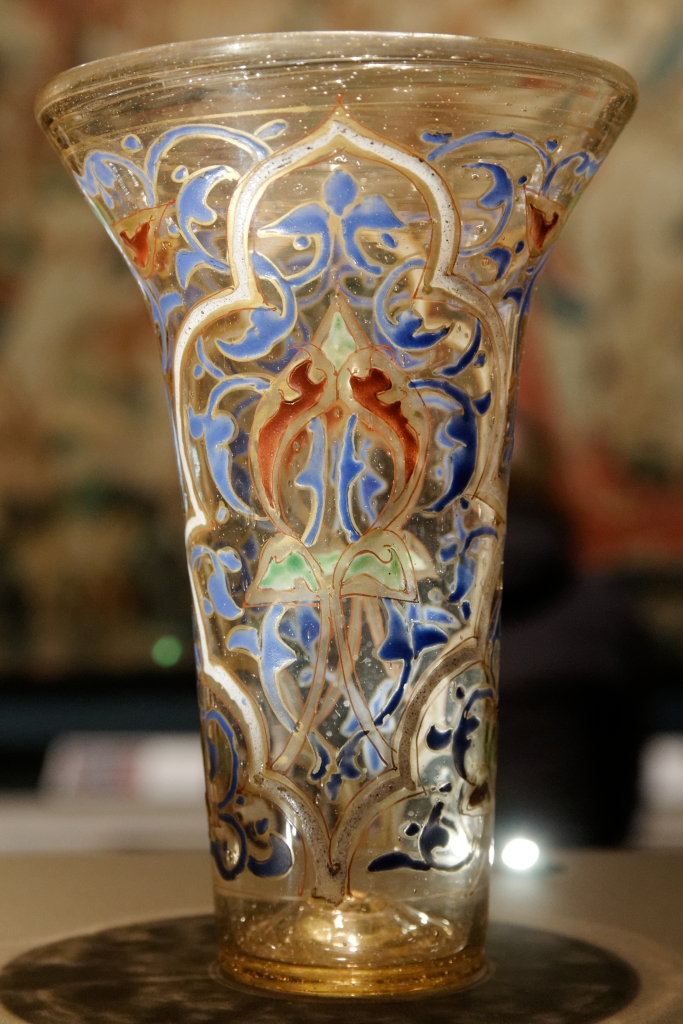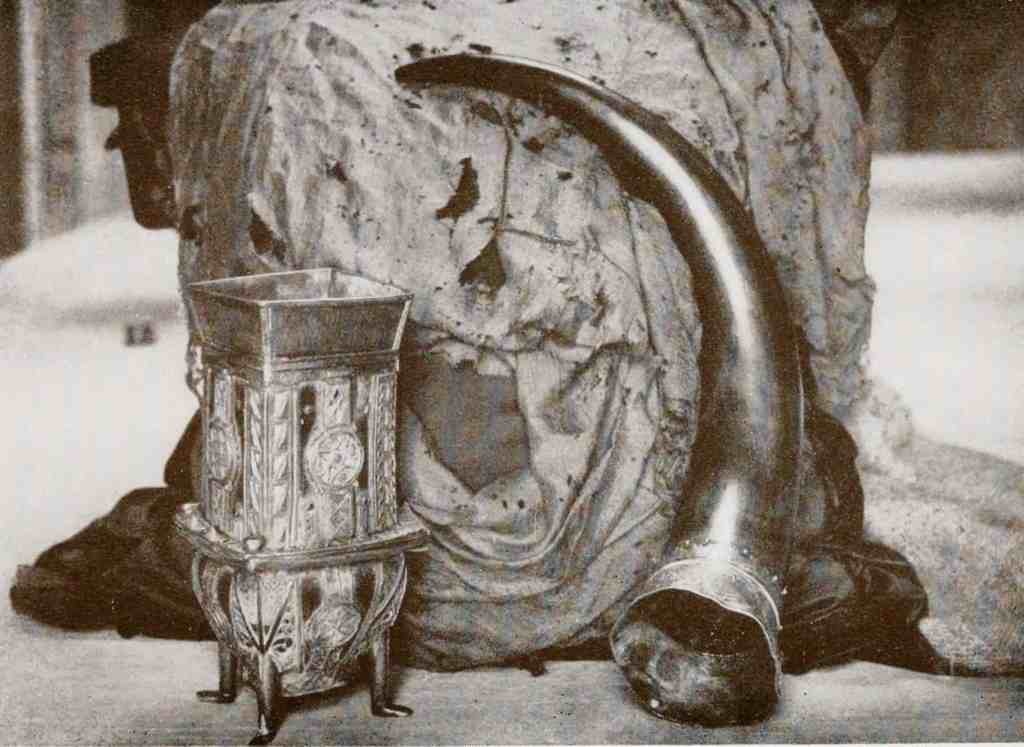
Faery drinking vessels feature prominently in British folklore. Acquired accidentally- or deliberately- from the faeries, they may be the vector of healing powers, as I have described in a post on trow cures. These vessels are typically of little value in themselves, being made of wood, bone, or ceramic, and they are taken because of their properties. Some though, are made of precious metals and are stolen for their cash worth; some are valuable both in monetary and practical terms. It’s these that I’m interested in here.
A butler boy called Luran, who served at Mingary Castle, on the Sound of Mull, entered a local faery mound and saw the faeries drinking from a “shining” magical cup which would fill with whatever liquid the holder asked for it to contain. The boy joined the celebration and, when the cup was passed to him, he asked for it to be filled with water, which he then used to douse the candles. In the sudden darkness, the boy made his escape with the cup in his hand; he was pursued, but an unknown voice told him to make for the shore. He then ran along below the highwater mark until he got to the castle, which he was able to enter using a secret stairway that led down to the beach. Luran reached safety with this magical cup by making use of a magical advantage, the fact that the sith folk, for reasons that are not entirely clear, cannot pass below the line of the hightide. Perhaps this aversion or impediment is related to the fact that water flows over the shore it twice daily (just as they cannot cross flowing fresh water); perhaps it is a result of the nature of briny water, for faeries notoriously can’t abide salt. Yet it doesn’t make full sense, because- as I’ve described- faery cattle just as often graze beneath the waves as on land.
We’ll have to leave this puzzle unresolved, but there’s plenty more to say about faery cups. Humans’ avaricious nature means that we have a long history of trying to steal these items from our faery neighbours. The oldest of these is William of Newburgh’s twelfth century account of a theft from Willy Howe in East Yorkshire. A man saw the faery hill open and light streaming out; he joined the feasting inside, was invited in and offered a drink of wine in a goblet. Cannily, the man didn’t risk consuming faery produce; instead he poured out the liquid and made off with the cup on his fast horse. This item “of unknown material, of unusual colour and of extraordinary form,” eventually was presented to King Henry I (1100-1135). The same king also features in a related story, this time told by Gervase of Tilbury. Near Gloucester, there was a mound where any huntsman could request a drink and a faery would appear bearing a cup. One hunter, instead of quenching his thirst, stole the cup and presented it to the Earl of Gloucester. Matters didn’t turn out as he’d probably anticipated, for he was executed as a thief and (again) the cup ended up with the king.
A third, undated, English story, from Edenhall near Penrith, recounts a theft by a butler from a faery gathering in the grounds of the hall. This vessel, the ‘Luck of Edenhall,’ came with a faery curse, though: if it was ever broken, the good fortune of Edenhall would end. Being made of glass, it has been very carefully treasured ever since. As it happens, the centuries of cherishing the cup came to nought in that the hall was demolished in 1934 because maintaining it had become too costly, and in 1958 the Luck passed to the Victoria and Albert Museum, were it can still be seen today (head of page).

These last examples are all English, but the majority, like the Mingary case from Argyllshire, are Highland Scottish. In The Peat Fire Flame, Alexander Macgregor tells of a man called Ewen on Raasay who stumbled upon a celebration in a faery knoll and, just as in East Yorkshire, managed to steal, rather than drink from, the marvellous cup offered to him. This time he escaped by dint of being a very good runner- faster even than the faeries’ dogs, which were set upon him (another version names the thief as Hugh MacLeod).
John Gregorson Campbell, who recorded the Mingary story, also recorded another from the same area and concerning another Luran- this time Luran Black who was farmer from Corryvulin on the coast of Ardnamurchan, at the northern end of the Sound of Mull. Luran found that his cows were dying, one by one, and suspected that the local sith folk of the knoll called the Culver were stealing them under the guise of death. He watched one night and, sure enough, a party of faeries came out of the hill and took one of his cows. Luran allayed their suspicions by helping to butcher it and, in gratitude, was invited in for a drink. As before, he seized a vessel and made a run for it and, as we’ve heard, was advised by a mysterious voice to run between high and low water. Luran escaped and appeared to have paid himself back for his stolen cattle. However, sometime later, he was travelling to Inverary Castle in a boat with the cup. During the passage over the water, both he and the vessel vanished completely. As for the helpful voice, it’s generally assumed by folklorists that this must have been another human who had been kidnapped or captured by the faeries (perhaps by drinking their wine).
The Reverend R. C. MacLeod tells an almost identical tale of a farmer called Lurran from Luskintire on Harris. He escapes pursuit because he has several advantages: he’s a quick runner, he crosses over a stream, and because he seeks shelter in his mother’s cottage. She is a witch and cast spells over the house which made it impossible for the fairies to enter. For some time Lurran never left the house unless his mother had put a spell on him, but one day he forgot, and went out with no magical protection. The fairies quickly found and killed him, and so avenged themselves for the theft of their cup. I have recorded before an extremely similar story from Dun Osdale on Skye, in which a faery cup is stolen and the mother protects her son with charms against faery vengeance- but she fails to guard him against human thieves, so that he’s murdered by a man stealing the goblet.
Another man called Luran, this time from South Uist, seems to have had a lucky escape. He entered a fairy knoll, sticking his knife in the threshold of the door so that it could not close forever behind him, and then stole a golden cup. As he fled the fairies called out “If porridge was Luran’s food, he would catch the deer.” Imprudently, perhaps, he took this as advice that it would make him even swifter and started to eat porridge as recommended. In fact, he put on weight and, when he rashly decided to make a return visit to the knoll, he was unable to outpace the fairies and was caught. Surprisingly, his captors settled for recovering their stolen cup and then let him go.

Luran is a common name in Highland stories of faery and mermaid encounters, just as faery cups are regularly stolen. The ‘Fairy Cup of Dunvegan,’ is an oak chalice mounted with silver owned by the Macleods of Dunvegan Castle on Skye. It came originally from Harris, stolen by a man from a faery knoll using a combination of trickery (he repeatedly called out a faery form of greeting that stopped them in their tracks and bought him time to widen the gap between them) coupled with the faery aversion to certain substances: when the man got home, he threw the chamber pot over his pursuers. Quite reasonably, the faeries hate urine and left him alone after that.
Lastly, we have two very similar accounts from the Isle of Man. A man once stole a silver cup from a ferrishyn feast at Cronk Mooar. The faery owners were, predictably, outraged and pursued him. He escaped by wading along the river there; the fairies called on him to walk on the stones, but he stayed in the water, and got away. A variant of this story involves the man being pursued as far as a cow shed; there he was able to sprinkle the cows’ urine (mooin ollee) at the doorway and around the walls as a defence against the fairies until dawn. When daylight came, they retreated to their hills and he was able to make his way home unmolested.
In conclusion, it’s hardly a surprise to learn that stealing faery cups is a dangerous (and sometimes fatal) enterprise. The thief needs physical prowess (either his own or a horse’s), as well as luck, daring and, very often, a knowledge of the various charms that can be deployed against faeries. More strangely, though, these stories of valuable faery cups are not really about the cups. The gold and silver vessels provide a reason for the adventures, but the real interest is in the way that a mortal can outwit and escape faery pursuers. The message for listeners is (to some degree), don’t steal from the faeries, but it’s more a lesson in what substances or strategies will defeat them. As for the cups, if they’re not retrieved by the faeries, they’re forgotten by the storytellers or, in spite of the effort invested in acquiring them, they’re given away surprisingly easily.
Great posting, John, and exceptionally informative. I loved reading all the tales you have set before us for our delectation. I was surprised to read your mention of the faery cup of Dunvegan Castle. As you know, I am related to the clan Macleods, and whilst I knew of the faery flag, I was ignorant of the existence of the faery cup. So, thanks for educating me.
I think I have already mentioned that, a year or more ago, in one of the dreams I was sharing with Her Ladyship, the setting we were in was very modern. We were sat opposite each other in some kind of works canteen and she was just starting on her dessert. She offered me some, but I declined. My attention, however, was drawn to the cup she was drinking from. In the modern setting we found ourselves in, it really stood out. It was some kind of golden goblet with strange writing around the rim. When I tried to pronounce the wording, she laughed and turned the goblet around to indicate that I hadn’t even started from the beginning!
I know it was ‘only’ a dream, but I do remember noting that she was not drinking from your typical canteen mug. This drinking vessel was something very special as befit her high-born status and position. She leads, we follow. The cup reflected that.
Phil
LikeLike